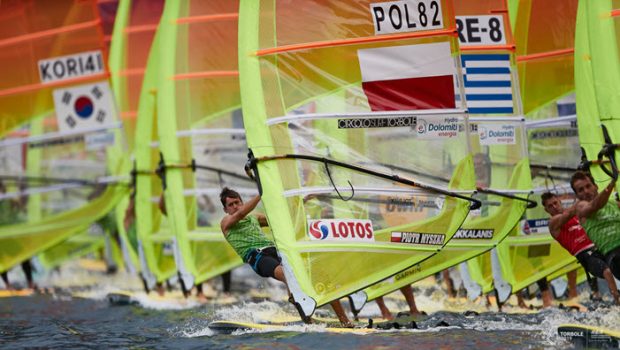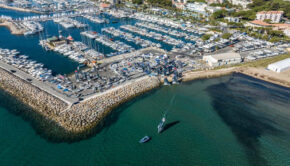Deciding what’s best for the sport
Published on October 27th, 2019
by Craig Leweck, Scuttlebutt Sailing News
Among the decisions made during the 2019 World Sailing Annual Conference (Oct. 26-Nov. 3) regards the future of windsurfing. While the decision specifically details the equipment for the Paris 2024 Olympics, the ramification will extend far beyond.
The RS:X equipment, introduced at the Beijing 2008 Olympics and approaching its fourth games, has been under review this year. The decision of its Olympic future will be made at this international meeting in Bermuda, and while the results of an equipment sea trials has selected new, foiling equipment, the final verdict will be more complicated.
From a purely performance position, no one design class boat or board is perfect, and odds are it becomes less perfect with each passing day. But performance isn’t the mission for one design classes. Their focus is to build community around the equipment.
So the position of changing Olympic equipment for the sake of performance can arguably have no end, but changing Olympic equipment has deep roots, so this is not about setting precedents. This is about deciding what is best for the entire sport.
Not surprisingly, the RS:X Class Association believes the work they have done is what’s best for the sport, and in this report by Class President Carlo Dalla Vedova, he details the reasons why:
This is an open letter to help you consider in equal terms the options for windsurfing equipment for the Paris 2024 Olympic Games. This is a hugely important decision that you are taking and the RS:X Class Association feel it is important that you have all of the facts and considerations available to you when decision making.
——
1. The RS:X windsurfing equipment: As put forward by NeilPryde in 2004, was the first piece of equipment that was specifically designed for the Olympics against criteria supplied by World Sailing (then ISAF). It was designed to be robust, long lasting, offered value and versatility, and can be sailed between 5 and 35 knots. The RS:X has been proven to live up to all of those specifications and more which is evidenced by the amount of boards from 2008 and 2010 that are still turning up and are competitive in events around the world today.
Whilst criticism has been leveled at the RS:X for being too heavy and over-built, this means that the boards are durable, robust and provide value for money. In a world where windsurfing equipment is mostly flown on airplanes around the world, having a light weight and fragile board will lead to more damage and will ultimately cost the sailors in repairs or new equipment.
2. Class Association: Another point for consideration is the efforts of the RS:X Class Association over the years. It has been proven that every time the axe has been threatened over the RS:X Class, it has had a significant impact on both the class association and the wider sport of windsurfing. For World Sailing to note that competitive windsurfing is in decline because of the RS:X Class Association is incorrect; it is because of the work of the RS:X Class that numbers have not declined worse over the instability offered by the lack of stability at World Sailing.
3. NeilPryde: The RS:X Class do acknowledge that its supplier, NeilPryde, have had some issues in supplying the class with timely equipment as well as the quality of the equipment. The RS:X Class have worked extensively with the manufacturer of RS:X equipment to ensure that the quality and supply chain are as good as possible for the sailors. Whilst doing so, the RS:X Class acknowledge the pressure on NeilPryde in supplying at cost equipment to three Olympic Games as well as 10 Youth World Championships in a time of increasing economic challenges. This should not go without credit to NeilPryde for supporting World Sailing in its ambitions over a significant period of time.
4. Record year: 2019 has seem some amazing records for the RS:X Class and for windsurfing in general. It is the year before the Tokyo 2020 Olympic Games, as 2015 was for Rio 2016 Games, but the numbers are better.
· Europeans: At the beginning of the year, 333 competitors descended on Palma, the majority of which where youth competitors, confirming the efforts of the RS:X Class in transitioning sailors from Techno to RS:X, the for the RS:X Europeans and Youth Europeans. This event kick-started a hugely positive year for the RS:X Class as it was held alongside the RS:X Emerging Nations program which saw 5 different nations taking part in windsurfing with a goal of the 2020 Olympics.
· Worlds: This followed with a biggest ever world championships in Garda, Italy in September 2019. 236 sailors from 47 different nations. The biggest ever women’s fleet (109 sailors), almost 50% of the entire fleet.
All whilst facing uncertainty over the future of the class. The RS:X Class have continued to support the ideals of World Sailing – pushing for equal participation within its fleets, pushing and promoting the sport to new nations around the world. An experienced class association who has knowledge of the sport, its international federation and the bigger picture is a key ally to World Sailing in supporting bigger picture objectives.
5. Change for change’s sake: The RS:X Class understand that there are faster, better, lighter options for the windsurfing events, as there are faster mono-hulls than the 49er, lighter boats than the Laser, more reliable boats than the Nacra 17. But when making decisions about change, the points to consider are not necessarily about what’s fastest or newest, it is about what is right for the health of the sport, the nations that have invested within World Sailings decisions and what the strategy needs to be longer term.
Change comes in many forms and change needs to be considered. A weeks worth of sea trials does not show the long term pedigree of a class or piece of equipment. It does not show record numbers. It does not show inspired athletes. It does not show the cost of change to the sailors and MNA’s that support World Sailing. When considering change, don’t think always about the equipment, think about the sailor, the coach, the youth sailors. Think carefully on change.
6. Value of windsurfing today/risks: The RS:X Class is the participation element of the Olympics, being accessible to a wider number of nations than any other piece of equipment bar the Laser. ANY change to equipment, regardless of promised subsidies, will significantly reduce the number of nations who will compete and challenge for qualification spots for 2024.
The RS:X Class acknowledge that World Sailing are making the decision to change or not to change – but now is not the time to gamble and hope that the latest experimental equipment will be better.
World Sailing should consider stability and security of the sport of sailing and of the discipline of windsurfing, and a managed change of equipment – with care and no risks. Foiling windsurfing is not proven. It is still developing. Is necessary to wait and test the existing and monitor the constant developments of the windsurfing foil. This is evident in the trials report where it is acknowledged that many lessons need to be learnt – it is simply not ready for Olympic scrutiny.
Windsurfing foil is still hugely expensive compared to recreational windsurfing and will only serve to widen the divide between the limited top “elite sailors” and the majority of the sport, the “sailors”, and in particular the “youth sailors”.
It may be inspirational for younger sailors, but for many but those who are able to afford it, it will simply be something that they cannot dream to achieve as it would simply be out of reach and too expensive.
——
Final: The RS:X Class simply ask for a managed change of the discipline with a possible new equipment, in order to continue to support the growth of windsurfing. To allow foiling windsurfing to mature alongside the RS:X Class for the next four years, such that any failure or lesson learnt, (i.e. the carbon mast of the Nacra 17 in its first cycle), are not at the cost of those putting their dreams on the line for Olympic gold and glory.
The RS:X Class ask for it to be considered for 2024 Games, and to monitor the development of foiling windsurfing/other/wing-surfer, to be eventually implemented in the future, which will allow stability of the existing windsurfing discipline, a more in depth valuation of the new discipline of foil windsurfing, and a smoother transition, to a new equipment; which will not chop the knees off a successful class that has demonstrated loyalty to World Sailing and the ideals of the Olympics.









 We’ll keep your information safe.
We’ll keep your information safe.